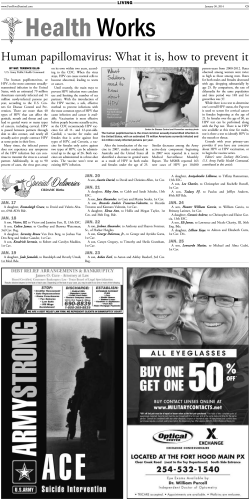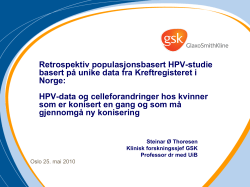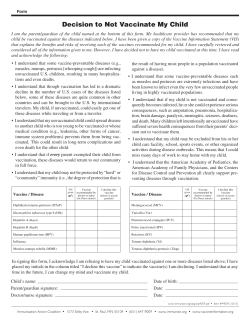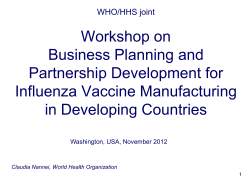
HPV Vaccination and Sexual Behavior in a Community College Sample
J Community Health DOI 10.1007/s10900-013-9710-0 ORIGINAL PAPER HPV Vaccination and Sexual Behavior in a Community College Sample Erica Marchand • Beth A. Glenn • Roshan Bastani Ó Springer Science+Business Media New York 2013 Abstract Many US parents are concerned that vaccinating daughters against human papillomavirus (HPV) will communicate implicit approval for sexual activity and be associated with early or risky sexual behavior (Scarinci et al. in J Womens Health 16(8):1224–1233, 2007; Schuler et al. in Sex Transm Infect 87:349–353, 2011) [7, 8]. The aims of this study were to understand (a) whether the HPV vaccine was associated with risky sexual behavior among a diverse sample of female adolescents and young adults, and (b) to better understand the chronology of HPV vaccination and sexual behavior. An anonymous web-based survey was used to collect data from 114 female community college students. T test and Chi square analyses were used to compare vaccinated and unvaccinated groups on age at first intercourse and proportion who had ever had sexual intercourse. Linear multiple regression was used to predict frequency of condom use and number of sexual partners in the past year, using vaccination status and demographic factors as predictors. About 38 % reported receiving at least one dose of the HPV vaccine. Many of those vaccinated (45 %) received the vaccine after having initiated sexual activity. The proportion of women who were sexually experienced did not differ by HPV vaccine status, nor did age at first intercourse, number of partners in the past year, or frequency of condom use. Current findings suggest that HPV vaccination is not associated with riskier sexual activity for the young women in this sample. Adolescents and their parents may benefit from education about the E. Marchand (&) B. A. Glenn R. Bastani Center for Cancer Prevention and Control Research, UCLA Fielding School of Public Health, 650 Charles E. Young Drive South, A2-125 CHS, Box 956900, Los Angeles, CA 90095, USA e-mail: [email protected] need to receive the HPV vaccine before onset of sexual activity. Keywords HPV vaccine Human papillomavirus Cervical cancer prevention College health Sexual behavior Introduction Two vaccines to prevent human papillomavirus (HPV) infection have been introduced in recent years. Both vaccines protect against the two strains of HPV that cause 70 % of cervical cancers [1, 2]. The Advisory Council on Immunization Practices (ACIP) recommends routine vaccination of girls 11–12 years old with either vaccine, and ‘‘catch-up’’ vaccination for those 13–26 years of age who were not previously vaccinated [3, 4]. Wide use of HPV vaccines could drastically reduce morbidity and mortality associated with cervical cancer in the US, but vaccine coverage has been low. Approximately 53 % of girls 13–17 years old and 29 % of young women 19–26 years old had initiated the vaccine in 2011 [5, 6]. Research indicates a substantial number of parents in the US are concerned that vaccinating daughters against HPV will communicate implicit approval for sexual activity, and will be associated with earlier or riskier sexual behavior [7, 8]. Fears that HPV vaccination will lead to adolescent sexual activity are linked to lower parental acceptance of the vaccine, [7, 8] and possibly to lower vaccine coverage. However, very few studies have directly examined the relation of HPV vaccination to sexual attitudes and behavior among young girls and adolescents in the US. A handful of reports have not found evidence of a link between HPV vaccination and more permissive sexual attitudes [9] or 123 J Community Health behavior among adolescent girls and young women in the United States [10, 11]. Therefore, additional work is needed to understand whether the HPV vaccine consistently lacks an association with risky sexual behavior, especially among diverse samples of women, and also to better understand the chronology of HPV vaccination and sexual behavior. Thus the aim of the current study is to investigate (a) when HPV vaccination occurred in relation to onset of sexual activity among a sample of female community college students, and (b) whether HPV vaccination status is associated with sexual behavior among these young women. Method Participants and Recruitment Data for the current study were collected as part of a larger project. Additional details about study methods are described in Marchand et al. [12]. Participants were recruited from the campus of a community college in central Los Angeles with total enrollment of 15,037. All female students between 18 and 26 years of age were eligible to participate in the study. The research team recruited participants in person and with posted fliers, class announcements, and word of mouth. Interested students self-selected to participate, and a total of 176 students provided usable survey data. Recruitment took place from September to November 2011. The UCLA Institutional Review Board approved the study protocol, and community college administrators granted necessary permissions. behavior, [16] and health care experiences. [17] Constructs used in the current study were: 1) 2) 3) Demographic information: Age; ethnicity (coded 0 = African American, 1 = other ethnicity); major in school (coded 0 = non-health-related, 1 = healthrelated); income (coded 0 = \$20,000 per year, 1 = $20,000 per year or more), and relationship status (coded 0 = married or committed, 1 = single, dating, separated, widowed, or divorced). HPV vaccine uptake: One item assessed whether respondents had received any doses of the HPV vaccine; responses were coded 1 = yes, 0 = no/don’t know. Sexual behavior: We focused on intercourse with male partners since this is the primary mode of HPV transmission for women. [18] Four items were used to assess sexual behavior. (a) ‘Have you ever had sexual intercourse with someone of the opposite sex?’ Responses were coded 1 = yes, 0 = no. (b) ‘How old were you the first time you had intercourse with someone of the opposite sex?’ Responses were continuous numeric values. (c) ‘During the past year, how many different people have you had sexual intercourse with?’ Responses were continuous numeric values. (d) ‘When you have sexual intercourse, how often do you or your partner wear a condom or use other barrier protection?’ Responses were coded 0/every time, 1/most of the time, 2/about half the time, 3/less than half the time, 4/never. Data Analysis Survey Procedures An anonymous web-based survey was used to collect data. Surveys were administered in two ways: (a) In person: 1 day per week during the data collection period, participants completed surveys on campus using laptop computers in a designated conference room, with the principal investigator present. (b) Remote: Participants were also able to log on to the survey website to self-administer the survey from any computer, at their convenience, with no study staff present. In both cases, participants went to the survey web address, read the online consent form, and indicated consent by clicking a button at the bottom of the page. The survey took 20–30 min to complete. Participants received a $10 gift card and printed information on HPV, cervical cancer screening, and the HPV vaccines. Survey Instrument Survey items were drawn from measures used in prior studies of HPV vaccination, [13–15] adolescent sexual 123 Data were screened for errors, improbable values, and duplicate submissions. This left a total of 176 surveys, 144 of which were completed in person and 32 completed remotely. Current analyses are conducted with the subset of participants who (a) had heard of HPV vaccines and therefore responded to the item assessing HPV vaccination, and (b) responded ‘yes’ or ‘no’ to the item asking whether they had ever engaged in sexual intercourse (final n = 114). Ethnicity was coded to facilitate comparisons between African American and other ethnic groups, since African American women have poorer sexual health outcomes in many domains, including higher rates of STI. [19] African American respondents (n = 37) were coded 0, and those who were Latina (n = 64) and other ethnicities (n = 13) were coded 1. T-test and Chi square analyses were used to compare vaccinated and unvaccinated groups on age at first intercourse and proportion who had ever had sexual intercourse. Linear multiple regression was used to predict frequency of J Community Health condom use and number of sexual partners in the past year, using vaccination status and demographic factors as predictors. Results Descriptive Statistics and Bivariate Comparisons Table 1 displays descriptive and bivariate statistics for vaccinated and unvaccinated women. The final analytic sample included 114 women; 42 of whom (36.8 %) reported receiving at least one dose of the HPV vaccine. Those who had initiated the vaccine were younger, on average, than unvaccinated peers. Of the women vaccinated, 19 (45 %) reported initiating sexual activity prior to vaccination, 7 (17 %) began sexual activity after vaccination, and 8 (19 %) experienced vaccine and sexual initiation at the same age. Overall, the average age at vaccination was approximately 18 years, while the average age at first intercourse was 16 years. Since the majority had been vaccinated after initiating sexual activity, we did not conduct further analyses to examine the relationship of vaccination to age at first intercourse. Participants reported an average of 1.7 partners in the past year and used condoms, on average, ‘‘about half the time.’’ These values did not differ between vaccinated and unvaccinated women. Multiple Regression Predicting Condom Use and Number of Sexual Partners Linear multiple regression models were used to examine associations of HPV vaccination with number of partners in the past year and frequency of condom use, controlling for demographic variables. For number of partners (Table 2), the regression model accounted for about 8 % of variance, Table 1 Demographic and descriptive statistics (n = 114) Age a Vaccinated Unvaccinated n Mean (SD) n Mean (SD) 42 21.0 (2.59) 72 22.0 (2.66) t p 2.06 0.04 33 16.2 (1.79) 61 16.7 (2.29) 1.01 0.32 Number of partners in the past yeara 33 1.7 (1.45) 61 1.7 (1.18) -0.04 0.97 Condom use frequency 33 1.9 (1.47) 61 Age at vaccination 41 18.34 (3.10) n/a n/a n/a n % n % chi2 Age at first intercourse Ever had intercourseb Yes 1.9 (1.64) 34 81.0 61 84.7 8 19.0 11 15.3 Hispanic/Latina 25 59.5 39 54.2 African American 13 31.0 24 33.3 Asian American 2 4.8 1 1.4 European American 1 2.4 1 1.4 Other/prefer not to answer 1 2.4 7 9.7 31 73.8 54 75.0 $20,000 or more 8 19.1 10 13.9 Prefer not to answer 3 7.1 8 11.1 Married/in a committed relationship 18 42.9 25 35.7 Single, dating, separated, divorced, or widowed 24 57.1 45 64.3 1 13 33.3 n/a n/a 2 11 28.2 3 15 38.5 No 0.07 0.94 n/a p 0.27 0.60 0.07d 0.79d 0.02e 0.89e 0.57 0.45 Ethnicity a These items were asked only of those who reported ever having intercourse b Responses of ‘‘prefer not to answer’’ are omitted, so totals add to \100 % c These items were asked only of women who had heard of the HPV vaccine d Chi square value is for comparison of AfricanAmerican to other groups combined e Chi square value is for comparison of \$20,000 to other groups combined Annual income $0–$19,999 Relationship status How many vaccine doses receivedc n/a n/a 123 J Community Health but did not fit the data well (R2 = 0.08, F = 1.30, p = 0.27). None of the variables examined were significantly associated with number of sexual partners in the past year. For condom use (Table 3), the regression model accounted for 25 % of variance (R2 = 0.25, F = 4.67, p = \0.01). Older age, lower income, and committed relationship status were associated with less frequent condom use. HPV vaccination was not associated with either sexual outcome. Since being in a committed relationship may have overshadowed other factors in predicting sexual behavior, exploratory multiple regression analyses were conducted with the subset of women in non-committed relationships (n = 53). For number of partners (Table 2), the model explained about 7 % of variance, but again did not fit the data well (R2 = 0.07, F = 0.66, p = 0.65). None of the predictors were significantly associated with number of partners. For condom use (Table 3), the model accounted for about 19 % of variance (R2 = 0.19, F = 2.27, p = 0.06). African American ethnicity was associated with more frequent condom use, but HPV vaccination was not related to the outcome. Table 2 Multiple regression analyses predicting number of partners in the past year Beta SE t p Effect size (r) 95 % CI for B Committed and non-committed relationships (n = 92)a Age Ethnicity (AAb vs. all others) 0.02 0.06 0.31 0.76 0.03 [-0.09, 0.13] -0.43 0.29 -1.46 0.15 0.15 [-1.00, 0.15] Relationship status 0.54 0.28 1.92 0.06 0.20 [-0.02, 1.11] Income 0.05 0.31 0.15 0.88 0.02 [-0.56, 0.65] -0.22 0.29 -0.75 0.45 0.08 [-0.80, 0.36] 0.06 0.29 0.22 0.83 0.02 [-0.51, 0.64] Major Received vaccine Non-committed relationships only (n = 53)a Age Ethnicity (AAb vs. all others) 0.02 0.09 0.26 0.80 0.04 [-0.16, 0.20] -0.67 0.44 -1.54 0.13 0.22 [-1.56, 0.21] [-0.58, 1.42] Income 0.42 0.50 0.84 0.40 0.12 Major 0.09 0.49 0.18 0.86 0.03 [-0.90, 1.07] -0.25 0.49 -0.52 0.61 0.07 [-1.24, 0.74] Received vaccine a Model includes only respondents who reported ever having intercourse b AA = African American Table 3 Multiple regression analyses predicting frequency of condom use Beta Committed and non-committed relationships (n = 92) Age Ethnicity (AAb vs. all others) 0.13 0.47 SE t p Effect size (r) 95 % CI for B 0.19 0.14 [0.00, 0.25] [-0.18, 1.11] a 0.06 0.32 2.04 1.44 0.04 0.15 Relationship status -0.05 0.32 -0.32 \0.01 0.31 [-1.67, -0.42] Income -0.73 0.34 -0.13 0.04 0.20 [-1.40, -0.05] Major 0.11 0.33 0.34 0.73 0.03 [-0.54, 0.76] Received vaccine 0.12 0.32 0.36 0.72 0.03 [-0.52, 0.75] [-0.07, 0.24] Non-committed relationships only (n = 53)a Age 0.08 0.08 -0.61 0.54 0.14 Ethnicity (AAb vs. all others) 1.00 0.38 2.63 0.01 0.35 [-0.24, 1.75] -0.68 0.43 -1.58 0.12 0.21 [-1.54, 0.19] Major 0.17 0.42 0.40 0.69 0.05 [-0.68, 1.01] Received vaccine 0.39 0.42 0.93 0.36 0.12 [-0.46, 1.25] Income a Model includes only respondents who reported ever having intercourse b AA = African American 123 J Community Health Discussion The current findings suggest that HPV vaccination is not associated with riskier sexual activity for the young women in this sample. These results are consistent with other findings [10, 11]. Our sample was unique in that many women had received the vaccine at a relatively late age, and most of them after onset of sexual activity. This likely reflects the fact that many of these women were already in their teens at the time of the HPV vaccine’s FDA approval, and were therefore vaccinated at older than currently recommended ages. Still, it is possible that parents and young women themselves need to be educated about the optimal timing of HPV vaccination (i.e., completion of the threedose series before the onset of sexual activity). It is notable that number of sexual partners and condom use, the main risk outcomes, were not related to vaccine status. Contrary to some concern about the vaccine encouraging riskier behavior, it does not appear that young women in this sample who were vaccinated chose to engage in riskier behavior than those who were not vaccinated. Indeed, factors other than those measured in the current study seem to account for much of the variation in numbers of sex partners. Some limitations in this study included the use of a relatively small convenience sample and self-report of vaccination, which may introduce inaccuracy or recall bias [20]. Still, the study had several strengths, including use of an anonymous survey to decrease socially desirable responding about sexual behavior, recruitment of a community college sample diverse in ethnicity and socioeconomic status, and assessment of contextual factors relevant to sexual behavior. The current results are consistent with other research finding no evidence of risky or sexual activity among young women vaccinated for HPV, and adds to a growing body of literature that may put to rest public fears about this issue. Acknowledgments This research was supported by the UCLA Cancer Education and Career Development Program, NCI Grant R25 CA 087949-13 and a grant from the UCLA Jonsson Cancer Center Foundation. The authors also wish to thank the staff and students of the Los Angeles Community College District, who made this research possible. References 1. Romanowski, B., de Borba, P. C., Naud, P. S., et al. (2009). Sustained efficacy and immunogenicity of the human papillomavirus (HPV)-16/18 AS04-adjuvanted vaccine: Analysis of a randomized placebo-controlled trial up to 6.4 years. Lancet, 374, 1975–1985. 2. Villa, L. L., Costa, R. L. R., Petta, C. A., et al. (2006). High sustained efficacy of a prophylactic quadrivalent human papillomavirus types 6/11/16/18 L1 virus-like particle vaccine through 5 years of follow-up. British Journal of Cancer, 95, 1459–1466. 3. CDC. (2011). Recommended adult immunization schedule: United States, 2011. MMWR, 60(4), 1–4. 4. CDC. (2011). Recommended immunization schedules for persons aged 0 through 18 years: United States, 2011. MMWR, 60(5), 1–4. 5. CDC. (2013). Adult vaccination coverage: United States, 2011. MMWR, 62(4), 66–72. 6. CDC. (2012). National and state vaccination coverage among adolescents aged 13 through 17 years: United States, 2011. MMWR, 61(34), 671–677. 7. Scarinci, I. C., Garce`s-Palacio, I. C., & Partridge, E. E. (2007). An examination of acceptability of HPV vaccination among African American women and Latina immigrants. Journal of Women’s Health, 16(8), 1224–1233. 8. Schuler, C. L., Reiter, P. L., Smith, J. S., et al. (2011). Human papillomavirus vaccine and behavioural disinhibition. Sexually Transmitted Infection, 87, 349–353. 9. Mullins, T. L. K., Zimet, G. D., Rosenthal, S. L., et al. (2012). Adolescent perceptions of risk and need for safer sexual behaviors after first human papillomavirus vaccination. Archives of Pediatric and Adolescent Medicine, 166, 82–88. 10. Bednarczyk, R. A., Davis, R., Ault, K., Orenstein, W., & Omer, S. B. (2010). Sexual activity-related outcomes after human papillomavirus vaccination of 11- to 12-year-olds. Pediatrics, 130, 798–805. 11. Liddon, N. C., Leichliter, J. S., & Markowitz, L. E. (2012). Human papillomavirus vaccine and sexual behavior among adolescent and young women. American Journal of Preventive Medicine, 42, 44–52. 12. Marchand, E., Glenn, B., & Bastani, R. (2012). Low HPV vaccine coverage among female community college students. Journal of Community Health, 37, 1136–1144. 13. Allen, J., Othus, M., Shelton, R. C., et al. (2010). Parental decision making about the HPV vaccine. Cancer Epidemiology, Biomarkers and Prevention, 19, 2187–2198. 14. Bastani, R., Glenn, B., Tsui, J., et al. (2011). Understanding suboptimal HPV vaccine uptake among ethnic minority girls. Cancer Epidemiology, Biomarkers and Prevention, 20, 1463–1472. 15. Roberts, M., Gerrard, M., Reimer, R., & Gibbons, F. (2010). Mother-daughter communication and human papillomavirus vaccine uptake by college students. Pediatrics, 125, 982–989. 16. Metzler, C. W., Noell, J., & Biglan, A. (1992). The validation of a construct of high-risk sexual behavior in heterosexual adolescents. Journal of Adolescent Research, 7, 233–249. 17. Safran, D. G., Kosinski, M., Tarlov, A. R., et al. (1998). The primary care assessment survey: Tests of data quality and measurement performance. Medical Care, 36, 728–739. 18. Veldhuijze, N. J., Snijders, P. J. F., Reiss, P., Meijer, C. J. L. M., & van de Wijgert, J. H. H. M. (2010). Factors affecting transmission of mucosal human papillomavirus. Lancet Infectious Disease, 10, 862–874. 19. Forhan, S. E., Gottlieb, S. L., Sternberg, M. R., et al. (2009). Prevalence of sexually transmitted infections among female adolescents aged 14–19 in the United States. Pediatrics, 124, 1505–1512. 20. Stupiansky, N. W., Zimet, G. D., Cummings, T., Fortenberry, J. D., & Shew, M. (2012). Accuracy of self-reported human papillomavirus vaccine receipt among adolescent girls and their mothers. Journal of Adolescent Health, 50, 103–105. 123
© Copyright 2025









